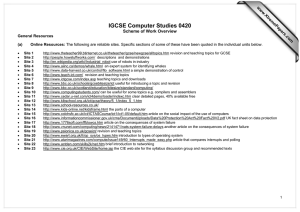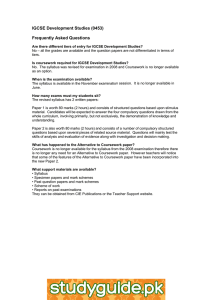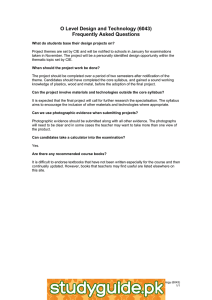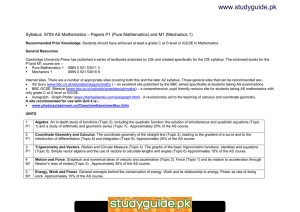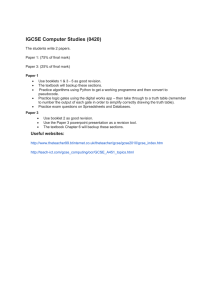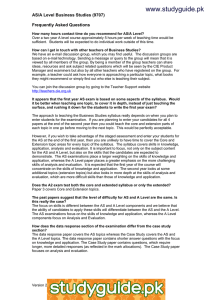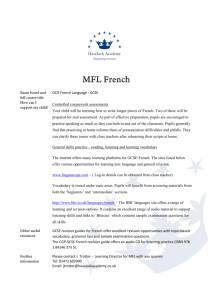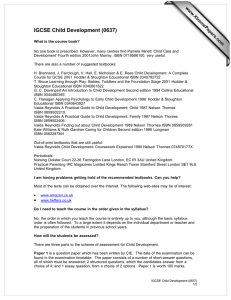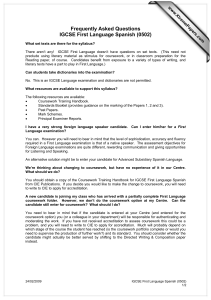O Level Computer Studies 7010 Scheme of Work Overview General Resources (a)
advertisement
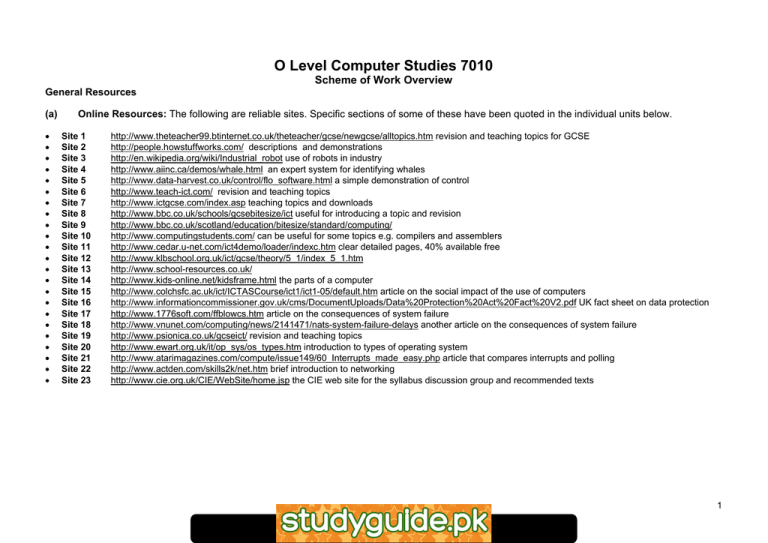
O Level Computer Studies 7010 Scheme of Work Overview General Resources (a) • • • • • • • • • • • • • • • • • • • • • • • Online Resources: The following are reliable sites. Specific sections of some of these have been quoted in the individual units below. Site 1 Site 2 Site 3 Site 4 Site 5 Site 6 Site 7 Site 8 Site 9 Site 10 Site 11 Site 12 Site 13 Site 14 Site 15 Site 16 Site 17 Site 18 Site 19 Site 20 Site 21 Site 22 Site 23 http://www.theteacher99.btinternet.co.uk/theteacher/gcse/newgcse/alltopics.htm revision and teaching topics for GCSE http://people.howstuffworks.com/ descriptions and demonstrations http://en.wikipedia.org/wiki/Industrial_robot use of robots in industry http://www.aiinc.ca/demos/whale.html an expert system for identifying whales http://www.data-harvest.co.uk/control/flo_software.html a simple demonstration of control http://www.teach-ict.com/ revision and teaching topics http://www.ictgcse.com/index.asp teaching topics and downloads http://www.bbc.co.uk/schools/gcsebitesize/ict useful for introducing a topic and revision http://www.bbc.co.uk/scotland/education/bitesize/standard/computing/ http://www.computingstudents.com/ can be useful for some topics e.g. compilers and assemblers http://www.cedar.u-net.com/ict4demo/loader/indexc.htm clear detailed pages, 40% available free http://www.klbschool.org.uk/ict/gcse/theory/5_1/index_5_1.htm http://www.school-resources.co.uk/ http://www.kids-online.net/kidsframe.html the parts of a computer http://www.colchsfc.ac.uk/ict/ICTASCourse/ict1/ict1-05/default.htm article on the social impact of the use of computers http://www.informationcommissioner.gov.uk/cms/DocumentUploads/Data%20Protection%20Act%20Fact%20V2.pdf UK fact sheet on data protection http://www.1776soft.com/ffblowcs.htm article on the consequences of system failure http://www.vnunet.com/computing/news/2141471/nats-system-failure-delays another article on the consequences of system failure http://www.psionica.co.uk/gcseict/ revision and teaching topics http://www.ewart.org.uk/it/op_sys/os_types.htm introduction to types of operating system http://www.atarimagazines.com/compute/issue149/60_Interrupts_made_easy.php article that compares interrupts and polling http://www.actden.com/skills2k/net.htm brief introduction to networking http://www.cie.org.uk/CIE/WebSite/home.jsp the CIE web site for the syllabus discussion group and recommended texts 1 www.xtremepapers.net (b) Definitions of Computing Terms on the Web: Some useful sites are: www.foldoc.org On-line computing dictionary http://whatis.techtarget.com/ IT and Computing definitions www.jworkman.com Web Site Production www.webopedia.com On-line Computing/IT dictionary (c) The list of websites provided for each topic is by no means exhaustive. Some of the sites in this scheme of work contain very useful information on other topics in the syllabus. It is, therefore, worthwhile navigating around some of the sites to extract as much information as possible. Further websites may be obtained using a variety of search engines available, some of which include: http://www.yahoo.co.uk/ http://www.google.com/ http://www.bbc.co.uk/ (Search the Web) http://www.altavista.com/ (c) Other resources: (General textbook other textbooks are on the website) IGCSE and O Level Computer Studies and Information Technology, by Chris Leadbetter and Stewart Wainwright (Cambridge University Press, ISBN 0521-5450-4), (Chapters are referenced in the scheme of work by prefix L+W) This text has been developed to cover the CIE syllabuses for Computer Studies and Information Technology. It includes syllabus section references in the margins. Explanations are thorough; extension work is placed in boxes, to separate it from the main text for ease of location. The style of the chapters is suitable for students starting IGCSE course. 2 www.xtremepapers.net UNITS Unit Unit title Outline of unit Syllabus references 1 Range and scope of computer applications The range and scope of computer applications including communication and information systems, on-line services, remote databases, commercial and general data processing, industrial, technical and scientific uses, monitoring and control systems, automation and robotics, expert systems and artificial intelligence, and miscellaneous other areas such as education and training, entertainment etc 1.1 2 The social and economic implications of the use of computers Social and economic effects on people and organisations associated directly with the application, on other individuals and organisations, and on society in general. 1.2 Economic reasons for the use of computers. Changes to and the development of new products and services. Changes in the working environment, employment and retraining. Privacy and integrity of data, data protection legislation, hacking and other computer crime, computer viruses. Security and reliability including consequences of system failure 3 Systems Analysis Principles of systems analysis practically applied to coursework. 2 Identification of the problem and stating it briefly. Deciding and stating specific outcomes, which are desired in the solution of a particular problem. Analysing the flow of information and data in existing (computer or manual) solutions. Evaluation of existing solutions and consideration of alternative solutions. 4 Algorithm design Algorithm design and testing. 3.1 Modular design. 3 www.xtremepapers.net 5 Programming concepts Practical programming in a high level language including – sequence, selection and repetition. 3.2 High level and low level languages and their uses. Translation programs including compilers, interpreters and assemblers. Pseudocode structures. User and technical documentation 6 Generic software Software for word-processing, database management, spreadsheets, graphics, communications, multimedia, data logging, CAD programming, desktop publishing and web design. 4.1 How applications packages solve sets of standard problems. Typical problems capable of solution by packages. Use of standard techniques or routines for established forms of processing. 7 Organisation of data The relationship between information and data; the collection of data; methods of ensuring its correctness (including validation and verification and the distinction between these); the coding of data for input; the presentation of useful information from processed data; analogue-to-digital and digital-to-analogue conversions. 4.2 File organisation: different forms of organisation, depending on the data stored and the requirements for processing; processing methods. Data types: numbers, characters, strings, arrays, the need for different data types and structures to represent the data of problems which are being solved using a computer. 8 Hardware Computer, microcomputer, microprocessor, standard input and output devices, broad classes of processor power. 5.1 The functions and characteristics of storage media. The characteristics and performance of a range of peripherals (including control and communication devices). 4 www.xtremepapers.net 9 Operating Systems Operating system facilities including file management, peripheral control, use of buffers, interrupts, polling, handshaking and checksums. 5.2 The nature of batch, online, multi-access, real-time transaction processing, multitasking, network and process-control operating systems. The form of interface between the operating system and the user; use of command line and use of graphical user interfaces. 10 Types of system Batch processing, single and multi-user online systems, network systems, control systems, automated systems and multi-media 11 The Coursework project A single piece of coursework of a substantial nature, involving the use of a computer to solve a specific problem, is to be carried out over an extended period. This will enable the students to use their skills and experience gained during the course to solve and document the solution to a problem 5.3 TEACHING ORDER Unit 1should be taught before Unit 2, Unit 3 before Units 4 and 5, Unit 9 before Unit 10 and Units 3, 4, 5 and 6 should be taught before project work is attempted or along side the appropriate sections of the coursework project. With these provisos the 10 units could be taught in any order, and taught sequentially or concurrently, depending on the resources available and the wishes of the teachers involved. 5 www.xtremepapers.net
